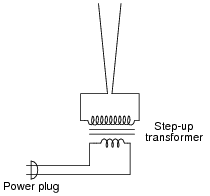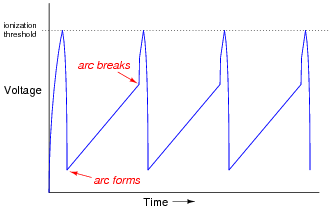Arc flash and arc blast
Question 1:
Electromechanical relays used to start and stop high-power electric motors (called "contactors" or ßtarters") must be considered a possible source of arc flash. Explain why this is. What is it about the construction or operation of such a relay that invites this dangerous phenomenon?
Notes:
Arc flash is just as hazardous to electrical technicians as electric shock, yet I have seen (and worked with) people who pay no attention to the dangers! It must be understood that motor starters are by their very nature arc-generating devices, and that under certain unusual conditions may generate lethal arc flashes. You might want to ask your students what sorts of unusual conditions could lead to a contactor producing an actual arc flash (rather than merely a few small sparks).
Question 2:
What, exactly, is an electric arc? What conditions typically lead to the formation of an arc?
Notes:
Discuss the subject of ïonization" of gases. Air is normally an insulator of electricity, but it becomes a conductor when ionized. Ask your students what happens to a gas when it becomes ionized. Ask them to tell you what the word ïonized" means.
Question 3:
What is the difference between arc flash and arc blast?
Notes:
Ask your students where they obtained this information. I have found much on this subject, including some very readable primary research, on the internet.
Question 4:
How hot can the temperature of an arc flash become?
Notes:
Note to your students that this temperature is roughly four times that of the Sun's surface!!! Very, very, hot an arc flash is! In fact, no materials known are able to withstand such extreme temperatures without becoming vaporized. It takes little imagination to realize what an arc flash can do to human skin.
Question 5:
What types of electrical systems pose a substantial threat of arc flash and arc blast?
Follow-up question: what types of job activities would likely bring a person into a situation where arc flash and arc blast are possible, or even likely?
Notes:
Not all electrical systems harbor the danger of arc flash and arc blast, but many do. While it may be obvious to some of your students that the small-scale electrical and electronic circuits they will be building in your course pose no threat of arc flash or arc blast, it is important to reassure the others that this is a hazard almost impossible to exist in a classroom environment.
Question 6:
A Jacob's Ladder is a novelty device designed to produce high-voltage arcs. It consists of a source of high voltage (usually a step-up "transformer" which takes the 120 volt AC utility power voltage and increases it to several thousand volts AC) and a pair of stiff wires or metal rods with a small air gap near the bottom and a large air gap near the top:

|
|
When powered, an arc develops at the point where the two rods are closest, then travels up the length of the rods, becoming wider and wider, until it "breaks" off the top of the rods. Once the arc is extinguished, a new arc forms at the bottom of the rods again.
Explain why the arc begins at the point where the rods are closest together. Also, explain why the arc then moves upward along the rods' length, rather than remaining at the bottom where the gap is shorter.
Challenge question: how do the principles behind the operation of a "Jacob's Ladder" relate to arc flash and arc blast in high-current electrical faults?
Notes:
Discuss with your students the nature of gas ionization, and why it occurs at the shortest gap first. Also discuss why the transformer's output voltage decreases once the arc forms. This has nothing to do with the transformer in particular as a power source, but would tend to happen with any high-voltage power source due to internal resistance.
One method of documenting the arc process in detail is to draw a graph of voltage between the rods over time:

|
|
The most important point of this question, though, is to relate these principles to the topic of ärc blast". How does the dramatic decrease in air resistance (after ionization) relate to the magnitude of arc current? How does the motion of the arc in a Jacob's Ladder relate to the high temperatures of an arc? What about the difference in gaps between the bottom of the rods versus the top - how does this relate to the physical size of arcs in an electrical power system fault?
Question 7:
What type of personal protective equipment ("PPE") is recommended for protection against arc flash and arc blast?
Notes:
The hazards of arc flash and arc blast are quite similar to the hazards faced by professional firefighters in their jobs, hence the similarity in protective equipment.
Question 8:
Arc flash may occur when using a voltmeter to measure voltage in a 480 volt electrical system, if there happens to be a power line transient (from a lightning strike, perhaps) at that time. Some industrial voltmeters carry a "CAT" rating (CAT I, CAT II, CAT III, CAT IV, etc.) specifying their tolerance for overvoltage transients, and subsequent safety provisions.
Describe in detail the meaning of these "CAT" ratings, and the nature of the hazard posed by a meter that fails under transient conditions.
Notes:
This question makes the point that personal protective equipment (PPE) is not the only line of defense against the hazards of arc flash. Test instruments also play an important role in electrical safety (or may contribute to the danger!). It is very important that electrical workers use quality tools for their work. A CAT-rated multimeter will cost more than one without a similar safety rating, but tell your students that the medical expenses incurred by an arc flash accident are far greater!
Question 9:
A potential cause of arc flash, and perhaps even arc blast, is improper meter use. Describe how an ammeter could be mis-applied to a live circuit in such a way that it causes an arc flash or arc blast.
Notes:
Discuss with your students why an ammeter should never be connected across a voltage source, especially a voltage source in an electrical power system. Relate this to the ideal input resistance of ammeters, and to Ohm's Law.
Question 10:
What is absolutely the best way to protect yourself from the dangers of arc blast while performing maintenance work on high energy electrical circuits?
Notes:
Students have asked me on many occasions if maintenance work on high-voltage systems is dangerous. My answer to this question is that ïf you follow proper procedure, it's all 0 volts by the time you touch it!" So, no, working on a de-energized 13.8 kV electrical system is no more dangerous than working on a de-energized 480 volt system or even a de-energized 120 volt system. All these voltages are lethal under the right conditions. The only real difference is psychological: high-voltage systems are scarier because the danger is more evident.
